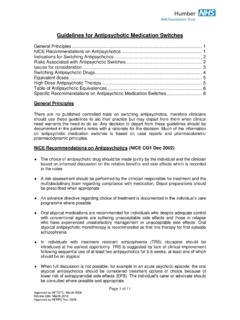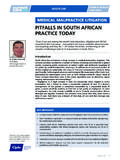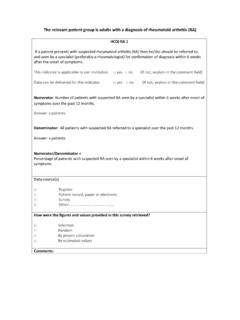Transcription of NOT FOR SALE OR DISTRIBUTION © Jones & Bartlett Learning ...
1 ObjectivesAfter reading this chapter, you will be able to:Implement systems of measurement commonly used in pharmacy practice. Practice operations involving ratios and proportions. Calculate drug doses. Describe four systems of measurement commonly used in pharmacy, and convert units from one system to the meanings of the prefixes most commonly used in metric measurement. Convert from one metric unit to another ( , grams to milligrams). Convert Roman to Arabic numerals Convert standard time to 24-hour military time.
2 Convert temperatures to and from the Fahrenheit and Celsius scales. Round decimals up and down. Perform basic operations with proportions, including identifying equivalent ratios and finding an unknown quantity in a proportion using percentages to and from fractions, ratios, and decimals. Perform fundamental dosage calculations and conversions. Solve problems involving powder solutions and dilutions. Use the alligation method to prepare solutions. Identify the basic units and prefixes of the metric system.
3 Convert units within the metric system by moving the decimal place, using the ra- tio-proportion method, and using the dimensional-analysis drug doses using the ratio-proportion and dimensional-analysis methods. Calculate doses based on weight and body surface area (BSA). Calculate a pediatric dose using the patient s weight or age and the appropriate adult Measurements and 1139/20/11 4:04:25 PM Jones & Bartlett Learning , LLC. NOT FOR SALE OR DISTRIBUTION . Jones & Bartlett Learning , LLCNOT FOR SALE OR DISTRIBUTION Jones & Bartlett Learning , LLCNOT FOR SALE OR DISTRIBUTION Jones & Bartlett Learning , LLCNOT FOR SALE OR DISTRIBUTION Jones & Bartlett Learning , LLCNOT FOR SALE OR DISTRIBUTION Jones & Bartlett Learning , LLCNOT FOR SALE OR DISTRIBUTION Jones & Bartlett Learning , LLCNOT FOR SALE OR DISTRIBUTION Jones & Bartlett Learning , LLCNOT FOR SALE OR DISTRIBUTION Jones & Bartlett Learning .
4 LLCNOT FOR SALE OR DISTRIBUTION Jones & Bartlett Learning , LLCNOT FOR SALE OR DISTRIBUTION Jones & Bartlett Learning , LLCNOT FOR SALE OR DISTRIBUTION Jones & Bartlett Learning , LLCNOT FOR SALE OR DISTRIBUTION Jones & Bartlett Learning , LLCNOT FOR SALE OR DISTRIBUTION Jones & Bartlett Learning , LLCNOT FOR SALE OR DISTRIBUTION Jones & Bartlett Learning , LLCNOT FOR SALE OR DISTRIBUTION Jones & Bartlett Learning , LLCNOT FOR SALE OR DISTRIBUTION Jones & Bartlett Learning , LLCNOT FOR SALE OR DISTRIBUTION Jones & Bartlett Learning , LLCNOT FOR SALE OR DISTRIBUTION Jones & Bartlett Learning , LLCNOT FOR SALE OR DISTRIBUTION Jones & Bartlett Learning , LLCNOT FOR SALE OR DISTRIBUTION Jones & Bartlett Learning , LLCNOT FOR SALE OR DISTRIBUTION114 UNit ONe Foundationchapter Overview77 Mathematics is important in pharmacy practice.
5 A mistake in a calculation or measure-ment could lead to serious consequences, such as underdosing or overdosing. This, in turn, may lead to inadequate treatment or drug all tasks within pharmacy practice relate to mathematics and calcula-tions: dispensing the correct volume of a solution, compounding a medication or determining a dose. These tasks involve basic arithmetic as well as an understanding of fractions, rounding numbers, ratios and proportions, and percentages. This chapter covers important topics relating to pharmaceutical measurements and and Numerals77 Number refers to a total quantity or amount, while a numeral is a word or symbol that represents a number.
6 The Arabic, or decimal, system and Roman numerals are the most commonly recognized and used systems of notation in pharmacy NumeralsThe Roman system of notation uses combinations of eight letters whose position indicates addition or subtraction from a succession of base numbers table . Bases include 1 2, 1, 5, 10, 50, 100, 500, and 1,000. Roman numerals are used for expression only and are not used for calculations. The values of each letter are shown combining letters, quantities other than the base values can be expressed.
7 The letters indicate a sum of their values when they are represented in equal or succes-sively smaller values. For example:II = 2 III = 3VI = 6 AccuracyAdmixtureAlligationBody-surface area (BSA)CompoundingConcentrationDilutionDos eDosagePrecisionProportionRatioRatio strengthSpecific gravityKey termstable roman Numeral baseLetterValueSS or ss1 2I or i1V or v5X or x10L or l50C or c100D or d500M or m1, 1149/20/11 4:04:25 PM Jones & Bartlett Learning , LLC. NOT FOR SALE OR DISTRIBUTION . Jones & Bartlett Learning , LLCNOT FOR SALE OR DISTRIBUTION Jones & Bartlett Learning , LLCNOT FOR SALE OR DISTRIBUTION Jones & Bartlett Learning , LLCNOT FOR SALE OR DISTRIBUTION Jones & Bartlett Learning , LLCNOT FOR SALE OR DISTRIBUTION Jones & Bartlett Learning , LLCNOT FOR SALE OR DISTRIBUTION Jones & Bartlett Learning , LLCNOT FOR SALE OR DISTRIBUTION Jones & Bartlett Learning , LLCNOT FOR SALE OR DISTRIBUTION Jones & Bartlett Learning .
8 LLCNOT FOR SALE OR DISTRIBUTION Jones & Bartlett Learning , LLCNOT FOR SALE OR DISTRIBUTION Jones & Bartlett Learning , LLCNOT FOR SALE OR DISTRIBUTION Jones & Bartlett Learning , LLCNOT FOR SALE OR DISTRIBUTION Jones & Bartlett Learning , LLCNOT FOR SALE OR DISTRIBUTION Jones & Bartlett Learning , LLCNOT FOR SALE OR DISTRIBUTION Jones & Bartlett Learning , LLCNOT FOR SALE OR DISTRIBUTION Jones & Bartlett Learning , LLCNOT FOR SALE OR DISTRIBUTION Jones & Bartlett Learning , LLCNOT FOR SALE OR DISTRIBUTION Jones & Bartlett Learning , LLCNOT FOR SALE OR DISTRIBUTION Jones & Bartlett Learning , LLCNOT FOR SALE OR DISTRIBUTION Jones & Bartlett Learning , LLCNOT FOR SALE OR DISTRIBUTION Jones & Bartlett Learning , LLCNOT FOR SALE OR DISTRIBUTION chapter 5 Pharmaceutical Measurements and Calculations 115 VII = 7 VIII = 8XI = 11LI = 51LV = 55CX = 110If a smaller value precedes a larger value.
9 Then the smaller value is subtracted from the larger value before the quantities are added together. For example:IV = 4IX = 9 XIV = 14 XIX = 19XL = 40 XCIX = 99CM = 900 Usually, capital letters are used to express years, while lowercase letters are used to express numerical values. Traditionally, capital Roman numerals have been used in pharmacy practice on prescriptions to designate the number of units prescribed or the quantity of medication to be administered. However, Roman numerals are increasingly being replaced by the decimal system in pharmacy numerals are sometimes preferred on prescriptions because they cannot be easily of measurement Used in pharmacy practice77 Several systems of measurement are employed in pharmacy: the common house-hold system, the avoirdupois system, the apothecary system, and the metric system.
10 Other notations of quantity and measure-ment include international units and mil-liequivalents. Pharmacy technicians should be familiar with all these systems, and be able to use them interchangeably. However, the metric system is the most common, and safest, system used in pharmacy and Avoirdupois Systems of MeasurementThe household and avoirdupois systems are the common measurements used in the United States for selling goods and food products, although they have been replaced in most other countries throughout the world by the metric household system of measurement is the one with which patients in the United States will be the most familiar.















